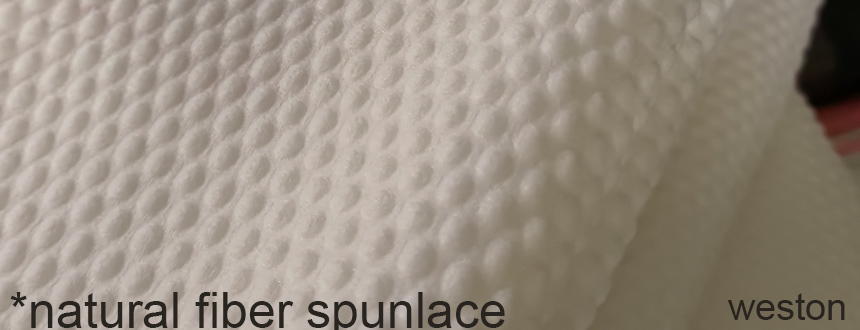What are biodegradable fibers?
Biodegradable fibers are fibers that can be naturally broken down by microorganisms and other biological processes into simpler compounds such as water, carbon dioxide, and other organic matter. These fibers are typically made from natural materials that can decompose without causing harm to the environment.
Some common examples of biodegradable fibers include:
Cotton: A natural fiber that is widely used in textiles and other products.
Wool: A natural fiber that comes from sheep and is used in clothing and other textiles.
Silk: A natural fiber that is produced by silkworms and is used in clothing and other textiles.
Bamboo: A fast-growing plant that can be used to make textiles and other products.
Hemp: A plant fiber that is like cotton and can be used in textiles, paper, and other products. Weston has successfully produced spunlace with hemp fibers, which is quite good for medical gauze and related treatment.
Jute: A plant fiber that is commonly used to make ropes, mats, and other products.
Biodegradable fibers are becoming increasingly popular as people become more concerned about the impact of synthetic fibers on the environment. By using biodegradable fibers, it is possible to create products that are more sustainable and environmentally friendly.
How about viscose or lyocell fiber?
Viscose and lyocell fibers are also considered biodegradable fibers. Viscose, also known as rayon, is made from wood pulp and is commonly used in textiles, such as clothing and bedding. Lyocell, on the other hand, is a type of rayon that is made using a closed-loop process that is more environmentally friendly than traditional viscose production.
Both viscose and lyocell fibers can be biodegraded by microorganisms in soil or water. However, it is important to note that the biodegradation process for viscose and lyocell fibers may take longer than some other natural fibers, such as cotton or wool. Additionally, the biodegradability of these fibers can also depend on various factors such as the specific conditions of the environment, the presence of other materials, and the manufacturing processes used.
Overall, while viscose and lyocell fibers are biodegradable, it is important to consider the entire life cycle of a product and its impact on the environment before making any conclusions about its sustainability.
Bamboo fiber spunlace
Bamboo fiber spunlace is a nonwoven fabric made from a combination of bamboo fibers and a spunlace manufacturing process. The spunlace process involves using high-pressure water jets to entangle and interlock the fibers together, creating a strong, durable, and highly absorbent material. Bamboo fiber is known for its natural antimicrobial properties, as well as its softness and breathability, making it an attractive choice for use in products such as cleaning wipes, baby wipes, and hygiene products. Bamboo fiber spunlace is also considered to be more environmentally friendly than some other types of nonwoven fabrics, as bamboo is a highly sustainable and renewable resource.
White color bamboo fiber and original color bamboo fiber
White color bamboo fiber and original color bamboo fiber both refer to nonwoven fabrics made from bamboo fibers, but the difference lies in the color of the fibers used to create the fabric.
White color bamboo fiber is made from bamboo fibers that have been bleached or processed to remove the natural color of the bamboo, resulting in a bright white fabric. This process can be achieved using a variety of bleaching agents, such as hydrogen peroxide or chlorine.
Original color bamboo fiber, on the other hand, is made from bamboo fibers that have not been bleached or processed to remove their natural color. This results in a fabric that retains the light brown or beige color of the original bamboo fibers.
Both types of bamboo fiber spunlace fabrics offer similar benefits in terms of softness, absorbency, and environmental sustainability. The choice between white color and original color bamboo fiber may depend on the desired aesthetic or functional properties of the final product, as well as personal preference.
Cotton fiber spunlace
Cotton fiber spunlace is a nonwoven fabric made from a combination of cotton fibers and a spunlace manufacturing process. The spunlace process involves using high-pressure water jets to entangle and interlock the fibers together, creating a strong, durable, and highly absorbent material. Cotton fiber is known for its softness, breathability, and absorbency, making it an attractive choice for use in products such as cleaning wipes, baby wipes, and hygiene products. Cotton fiber spunlace is also considered to be more environmentally friendly than some other types of nonwoven fabrics, as cotton is a natural, biodegradable material that can be sustainably grown and harvested.
Lyocell spunlace
Lyocell spunlace is a nonwoven fabric made from a combination of lyocell fibers and a spunlace manufacturing process. Lyocell is a type of cellulose fiber made from wood pulp that is known for its softness, strength, and absorbency. The spunlace process involves using high-pressure water jets to entangle and interlock the fibers together, creating a strong, durable, and highly absorbent material.
Lyocell spunlace is used in a wide range of applications, including personal care products, such as facial wipes and baby wipes, as well as medical and industrial applications, such as surgical gowns, drapes, and cleaning cloths. Lyocell spunlace offers several benefits over other types of nonwoven fabrics, including superior softness, high absorbency, and excellent strength and durability. It is also considered to be a more environmentally friendly alternative to some other types of nonwoven fabrics, as lyocell is a renewable resource and the manufacturing process is less harmful to the environment.

